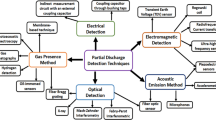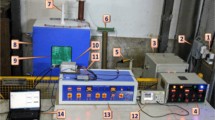Abstract
High-temperature vulcanized silicone rubber insulators are widely used in high-voltage transmission lines and substation equipment because of their excellent fouling resistance. The aging of silicone rubber occurs due to environmental factors as its operating life advances and is closely related to its production formulation. Establishing a classification method for insulator chemical formulations is beneficial regarding operational performance and proposing a more reasonable operating scheme for composite insulators. However, the silicone rubber production formulations of various manufacturers are usually confidential, and there is no technology that can quickly identify insulator chemical formulations. In this study, a rapid classification method for composite insulator chemical formulations was investigated based on laser-induced breakdown spectroscopy (LIBS). Returned insulators from seven different manufacturers are considered as the research object. Spectral data were collected separately, and the insulators were initially classified using the characteristic spectral lines of the elements corresponding to different fillers doped in silicone rubber. The spectral data were characterized using a recursive feature elimination algorithm for feature selection and a linear discriminant algorithm for data dimensionality reduction in the characteristic spectral data. Accordingly, the insulators were classified using a backpropagation neural network algorithm, achieving the best experimental results with an accuracy of about 95%. Thus, LIBS technology can achieve rapid classification of insulator chemical formulations, which can provide a basis for formulation correlation for the operation and maintenance of composite insulators, as well as guarantee the safety of transmission lines.







Similar content being viewed by others
References
Yu Z, Guangya W, Rui Z (2006) Operating characteristics and analysis of high temperature vulcanized silicone rubber. Electr Porcelain Electr Porcelain Arrester 03:18–22
Liu Y, Wang Q, Lv F, Liang Y (2010) Effect of ultraviolet radiation on properties of high temperature vulcanized silicone rubber. High Volt Technol 36(11):2634–2638
Meng X, Mei H, Zhu B, Yin F, Wang L (2022) Influence of pollution on surface streamer discharge. Electr Power Syst Res 212:108638. https://doi.org/10.1016/j.epsr.2022.108638
Wei S, Wenwei S, Guoli W, Yulu W, Guanjun Z (2013) Effect of corona discharge aging on trap characteristics of high temperature vulcanized silicone rubber. High Volt Technol 39(04):979–986
Nianping Y, Ziyi F, Hua W, Zheng C, Zhidong J (2017) Aging status and characterization technology of high temperature vulcanized silicone rubber. Insulation 50(12):1–9
Wang L, Zhou K, Zhao C et al (2012) Experimental verification of evaluation system for external insulation condition of saturated damp insulators. High Volt Technol 38(8):7
Zhu Hu, Weiguo Li, Ye L (2006) Status and development of insulator detection methods. Porcelain Light Arrester 06:13–17
Cheng L, Liu Y, Chen R et al (2022) Method for predicting the water absorption of external insulating silicone rubber. IEEE Trans Dielectr Electr Insul. https://doi.org/10.1109/TDEI.2022.3183653
Zhang S, Cheng L, Liao R et al (2022) Process improvement to restrain emergency heating defect of composite insulator. IEEE Trans Dielectr Electr Insul 29(2):446–453. https://doi.org/10.1109/TDEI.2022.3157929
Yang R, Zhou X, Luo C et al (1991) Modern instrumental analysis of polymers. Tsinghua University Press, Beijing
Pablo A, Foster A (2020) Guide to laser-induced breakdown spectroscopy. Nova Science Publishers, Inc., New York
Liu F, Wang W, Shen T et al (2019) Rapid Identification of kudzu powder of different origins using laser-induced breakdown spectroscopy. Sensors 19(6):1453–1463
Zhu Y, Yang P, Yang X, Li J, Hao Z, Li Q, Guo L, Li X, Zeng X, Lu Y (2017) Identification of fresh meat varieties by Support vector machine combined with principal component analysis and Laser-induced breakdown spectroscopy. Anal Chem 45(03):336–341
Yu X, Peng J, Liu F, He Y (2017) Laser-induced breakdown spectroscopy technology for rapid identification of matcha and green tea powder. Spectrosc Spectr Anal 37(06):1908–1911
Li W, Chen G, Zeng Q, Yuan M, He W, Jiang Z, Liu Y, Nie C, Yu H, Guo L (2021) Fiber optic laser- induced breakdown spectroscopy for rapid detection and classification of iron and steel. Spectrosc Spect Anal 41(08):2638–2643
Sungho S, Youngmin M, Jaepil LEE et al (2020) Improvement in classification accuracy of stainless steel alloys by laser-induced breakdown spectroscopy based on elemental intensity ratio analysis. Plasma Sci Technol 22(7):074011
Yu Q, Ma X, Wang R, Zhao H (2014) Research on rapid classification method based on LIBS and principal component analysis. Spectrosc Spect Anal 34(11):3095–3099
Meng D, Zhao N, Ma M, Gu Y, Yu Y, Fang L, Wang Y, Jia Y, Liu W, Liu J (2017) Study on rapid soil classification based on Laser-induced breakdown spectroscopy technique. Spectrosc Spect Anal 37(01):241–246
Lanza NL, Wiens RC, Clegg SM et al (2010) Calibrating the ChemCam laser-induced breakdown spectroscopy instrument for carbonate minerals on Mars. Appl Opt 49(13):211–217
Park J, Kumar S, Han SH et al (2021) Combination of diffuse optical reflectance spectroscopy and laser-induced breakdown spectroscopy for accurate classification of edible salts. Spectrochim Acta Part B 179:106088
Wang X, Wang H, Chen C et al (2016) Ablation properties and elemental analysis of silicone rubber using laser-induced breakdown spectroscopy[J]. IEEE Trans Plasma Sci 44(11):2766–2771
Wang X, Liu X, Lu S, Qin X, Wang X, Jia Z (2022) Insulator glucose Laser-induced breakdown spectroscopy detection. High Volt Technol 48(03):876–882
Martin W, Wiese W, Musgrove A et al (2005) NIST atomic spectra database. Memorie Della Societa Astronomica Italiana Supplementi 8(1):96
Ji C, Guan Y, Zhang X, Li X, Wang X, Sun D (2015) Research progress of RTV silicone rubber anti-pollution flashover coatings. Coat Ind 45(11):81–87
Niu W, Zhang X, Qiao J, Yang H, Hou K (2020) Optimum design of silicone rubber filler for thermal insulation. New Chem Mater 48(01):115–119
Gao W, Wang Q, Yang S, Deng X, Xie Z (2000) Reinforcement effect of calcium carbonate and silicon carbide on RTV silicone rubber. J Polym Sci 2000(01):1–4
Xue Y, Li X, Zhang D et al (2018) Comparison of ATH and SiO2 fillers filled silicone rubber composites for HTV insulators. Compos Sci Technol 155:137–143
Lin Y, Wang L, Yin F et al (2019) Comparison of four commonly used high temperature vulcanized silicone rubber formulas for outdoor insulator and their regional adaptability. J Appl Polym Sci 136(19):47477
Rubber basics[M]. iSmithers Rapra Publishing, 2002
Wang JC, Pan XC, Xue Y et al (2012) Studies on the application properties of calcium sulfate whisker in silicone rubber composites[J]. J Elastomers Plast 44(1):55–66
Zhang J (2014) Research on classification feature selection algorithms for high dimensional small sample data [D]; Hefei University of Technology
Qin S, Li M, Dai Y, Gao X, Song C, Lin J (2022) Spatial binding Support vector machine improves the accuracy of Fe analysis in Laser-induced breakdown spectroscopy aluminum alloys [J]. Spectrosc Spect Anal 42(02):582–586
Liu X, Zhang D, Feng Z, Ding J, Yang R, Sun S, Wang K, Zhu J, Wei Z (2021) Aircraft alloy identification based on remote Laser-induced breakdown spectroscopy technology. J Photonics 50(10):173–180
Zhao W, Min H, Liu S, An Y, Yu J (2021) Application progress of artificial neural network in Laser-induced breakdown spectroscopy data analysis. Spectrosc Spect Anal 41(07):1998–2004
Funding
This work was supported by the National Natural Science Foundation of China (51677101), and Shenzhen fundamental research and discipline layout project (No. JCYJ20180508152044145).
Author information
Authors and Affiliations
Contributions
JS contributed to data curation and investigation; XQ contributed to investigation and methodology; QL contributed to data curation, investigation and methodology; WF contributed to methodology and formal analysis; QW contributed to methodology and writing; XW contributed to project administration and investigation; ZJ contributed to funding acquisition.
Corresponding author
Ethics declarations
Conflict of interest
The authors declare that they have no known competing financial interests or personal relationships that could have appeared to influence the work reported in this paper.
Additional information
Publisher's Note
Springer Nature remains neutral with regard to jurisdictional claims in published maps and institutional affiliations.
Rights and permissions
Springer Nature or its licensor (e.g. a society or other partner) holds exclusive rights to this article under a publishing agreement with the author(s) or other rightsholder(s); author self-archiving of the accepted manuscript version of this article is solely governed by the terms of such publishing agreement and applicable law.
About this article
Cite this article
Song, J., Qin, X., Lyu, Q. et al. Classification study of composite insulator chemical formulations based on laser-induced breakdown spectroscopy. Electr Eng 105, 1775–1782 (2023). https://doi.org/10.1007/s00202-023-01771-0
Received:
Accepted:
Published:
Issue Date:
DOI: https://doi.org/10.1007/s00202-023-01771-0




